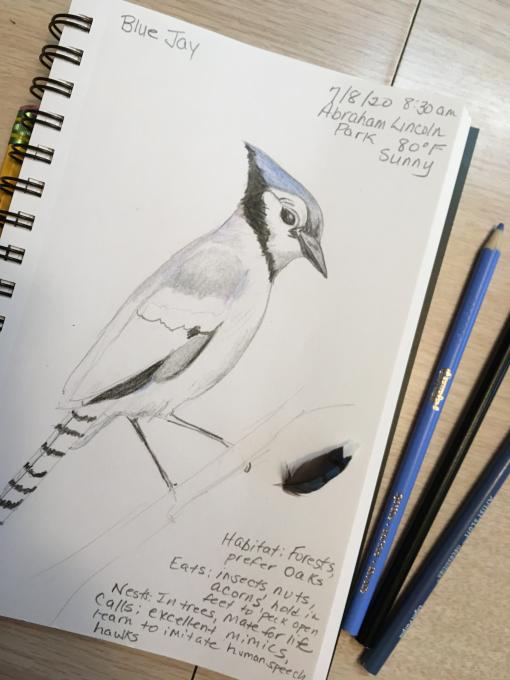The Cornell Lab Bird Academy › Discussion Groups › Joy of Birdwatching › Activities: Keeping Track of Your Birdwatching
-
When I first began birding late this summer, I would just go out and not keep track of what I saw, becoming more familiar with using my binoculars and getting good sightings of birds, as well as using sound to find birds. Recently, I began keeping a list of birds during each trip with a pen and small note pad, which fits handily in a coat pocket. Writing down observations even regarding species I'm fairly familiar with now has really helped my understanding of birds, their behaviors, and in which kinds of habitats I expected to see different kinds of birds. In a few instances, it has also helped me make an ID without having to reach into my bag and pull out my guide book. Instead, I have been able to maximize the amount of time I spend actually watching the bird, jotting down notes about appearance, habitat, and behavior, then thereafter making an ID. Especially when I get to a "hotspot" where I am seeing and hearing multiple birds at once, I am able to make my observations and enjoy watching the birds for as long as possible, then I make notes before continuing on the trip. The eBird app is a great tool as well. I've begun entering my sightings into eBird and find the database and tracking of my old checklists very useful as I compile a "life list". It has also helped me tremendously in finding new great birding locations, as I can see that frequently visited spots by experienced birders have been highly productive. I didn't even realize just how many great birding spots there are so close to a major city (Boston, MA) until I started using eBird.
-
I have not gotten into the habit of taking field notes, I started using Merlin pretty much in the beginning and it records the date and location as well as ebird so I have been using that as my memory of seeing the bird, I should probably right down what it was doing for the new birds or any behaviors that I find interesting but I feel like its one more thing to carry haha and I am lazy. I signed up for ebird alerts at the start of this course, which has been nice, I started joining classes at the local Audubon but then they got cancelled due to Covid :( hopefully soon
-
Activity 2: I am in multiple birding groups centered around sharing rare bird sightings in my area. I also am signed up for rare bird alerts in my county and surrounding counties. I love to try and go see a rare bird that I hear about. Often because of my job I am not able to make it in as timely a manner is needed to really take advantage but I have several times seen birds because of the alerts, as well as, contributed to them myself.
-
Activity 1: In the past I kept a birding journal. There was a lot of good information in my old journal. I documented the time, date, temperature, and general weather observations at the start of each entry. Then I documented all the birds I saw, what they were doing, and any unusual behaviors. I find that my own notes serve as a great source for knowing what birds to expect to see in my own yard at any given time of year. Because of this assignment I decided to give field notes a better try, as far as really looking for descriptors and field marks. I found that even if I looked at a bird I know well (or maybe especially a bird I know well) that I noticed more about it's coloration and markings when thinking about if I were to draw it. I think drawing pics of the birds is probably out for me. I did try and draw a picture of a female Northern Cardinal that had lost her tail that was at my feeder. It really ended up looking like a rubber ducky not a Northern Cardinal. LOL. I think the notes and concept are very helpful but art takes too much focus on the art itself and is not something I can just do in the field. I have never been organized and really kept a list of all the birds I have seen. At various times I have checked off various checklists but not been organized about it and do not even know where many of them are anymore. Since being introduced to ebird I use it every day. I really love that it keeps track of what I have seen and where. I also got a camera for my birthday (August 13, 2020) and I have been working on my bird photography skills. I try to take pictures every day. Some turn out really good and others not so good. I love adding the pictures to my ebird lists. I find that it is a great way to document what I have seen. I like many others have mentioned with this assignment, use my photos to get my ids correct. This is really helpful for many of the shorebirds. I upload ones that I am not confident in to Merlin and can usually get some clarification. I also am a member of multiple Facebook groups that are for bird id. I have used them several times to get opinions on birds that were difficult.
-
Activity 1: The first observation in my Roger Tory Peterson, "A Field Guide to Western Birds," dates back to 1982, although I had been watching birds long before that date. Since then, my notes over the years, in Peterson as well as in my other favourite, Nat Geo's "Field Guide to the Birds of North America", are pretty messy (see photos!) with no bird ID strategies mentioned, except for the 1987 insert shown here when I saw a Mandarin Duck swimming in Lost Lagoon in Vancouver, BC's Stanley Park. This stunningly beautiful duck is native to Asia, but occasionally seen on ponds around the west coast of BC -- apparently there was one spotted in Burnaby, BC this year. The side column in my Nat Geo guide (second photo) lists all the birds that came to my backyard feeders during March, April and May 2020 COVID-19 shutdowns. They added so much joy to the proceedings! Since beginning this course, though, I have thought about getting my life list in order to see how extensive it is. Activity 2: I am subscribed to rare bird alert emails on ebird, which does pique my interest from time to time. Sometimes, I wonder, "Really? Could that be true?" when someone cites a bird that seems rare indeed to be seen in our area. Then, I remember the Mandarin Duck.


-
Activity 2: I signed up for rare bird alerts on eBird.
-
Activity 1: I use eBird to record my birding observations. On one of my checklists, I saw a bird that was listed as being rare for my location and date (White-breasted Nuthatch). eBird required me to record comments about my observation of this bird. I just put something simple down, like I saw it climbing a tree. Later, I received an email from a regional volunteer asking for further detail about the observation. I went back in to eBird and documented a more thorough description of the bird's behavior, habitat, and field markings. I can see how the more detailed the field notes are, the more reliance can be placed on the observation (especially when coming from a novice like me). I've also started bringing a camera with me when birding to try and get some photos of birds. The birds don't always stay still long enough for me to get a photo, but I have succeeded in snapping a few pictures of American Robins and Black-capped Chickadees.
-
 My oldest bird notes were written in my field guide ; when and where I saw the bird as seen on the right side of the photo. Later I began making lists of all the birds I saw, the date and where I was birding as seen on in the notebook on the right.
My oldest bird notes were written in my field guide ; when and where I saw the bird as seen on the right side of the photo. Later I began making lists of all the birds I saw, the date and where I was birding as seen on in the notebook on the right. When I began using E-bird I started recording bird counts, start and end times and some notes in addition to the date and location. Most of the places I bird have no cell phone signal so I still record everything in my notebook using a kind of shorthand. I use abbreviations for a lot of the common birds(WBNH- White Breasted Nuthatch, TTM- Tufted Titmouse etc) as well as my usual locations. I also use tick marks for the counts. This makes it easy to add more birds of the same species as I see them.
When I began using E-bird I started recording bird counts, start and end times and some notes in addition to the date and location. Most of the places I bird have no cell phone signal so I still record everything in my notebook using a kind of shorthand. I use abbreviations for a lot of the common birds(WBNH- White Breasted Nuthatch, TTM- Tufted Titmouse etc) as well as my usual locations. I also use tick marks for the counts. This makes it easy to add more birds of the same species as I see them. -
Our local birding club is apparently not meeting at present due to coronavirus restrictions. As I beginner, I could really use some mentoring. I'm having a hard time with the logistics of birdwatching. I have terrible vision, wear glasses, and only have an inexpensive pair of binoculars at this point (7X). It is a bit awkward using the binoculars with my glasses on, and if I try to take them off, it is just one more thing to handle and fumble. I tend to locate the birds without binoculars, but when I switch to binoculars, it is hard to find the same location on the tree. By the time I find the right spot, the bird has often flown away. I'll also need to experiment with different times of day, different levels of sunshine, different angles. Even when I can focus on a bird, it is often backlit, making it hard to see any colors and markings. I also find the position (standing, looking up) to be uncomfortable (hurts my neck). My only camera is my cell phone, and I can barely get photos of our feeder birds let alone birds in treetops. I have a small notebook that I've used for field notes, mostly around our yard. I've found it helpful to write down my best interpretation of the vocalizations that I hear. I walked around a park today, heard at least 7 or 8 different birds but couldn't see any of them. It's frustrating, but I'm still having fun! I'm sorry if this post sounds like I'm complaining. My awkward attempts so far are truly a comedy of errors. I do feel connected to the community through our local Wild Birds Unlimited store which offers expertise along with occasional presentations, and I really enjoy the WBU Backyard Birds Photos on FaceBook. I am pretty good at identifying feeder birds. I received my Project Feederwatch package earlier this week, and I look forward to participating for the first time. I'm also using eBird to look at lists submitted by local birders.
-
Activity 1: I take a lot of pictures and videos during my field trips. Then I analyze them calmly at home. I feel really overwhelmed with information and excitement and most likely miss on a lot of details during my bird watching. Pictures help to identify birds with the help of books and Merlin ID app. Songs captured in videos help to figure out birds that I couldn’t see or photograph. Activity 2: I joined a Facebook group and keep my eye open on any planned activity in the world of bird watching in our city. Last year I was lucky to meet authors of my 2 bird books. Talking to them was very inspiring!
-
Activity 1: I pulled over near a swamp and spent 10-15 minutes in the field viewing birds and taking notes. I spotted a redwing blackbird and observed what appeared to be territorial behaviour. Field notes were helpful in reminding me what I saw. Activity 2: I'd like to start a group called the Thousand Islands Birdwatchers Association. Does anyone have any advice for starting a birding group? My vision is a remote group on FB for the time being to limit in-person gathering.
-
Since I am new to birding, I seldom know what kind of bird I am seeing, so here is what I do. I take photos of the bird with my real camera (not a phone camera) because I have a 30x optical zoom so I can get a close-up photo of a far-away bird. When I get home, I copy the photo to my computer and enlarge it for a better view. Then I use Merlin Bird ID to figure out what the bird is. Then I add it to my list of birds I have seen, which I keep in an Excel spreadsheet. A couple days ago I had my best birding day ever, as I saw two kinds of herons on the same day. Here are my photos of the green heron and the great blue heron.


-
Agree - it is a good idea to use a camera with a better quality lens than what the cell phone has. I will have to rediscover my camera, haven't used it in years! Nice pix of the herons!
-
I use my camera the same way, and it’s helping me to learn and identify new species. I shoot at just about anything that moves if I can’t easily determine the species, and I’m up to 161 species in my area so far. It is embarrassing when a seasoned birder asks what I’m looking at or for—essentially I’m looking for anything I haven’t seen yet! I also keep a journal where I list where I’ve been and what I’ve seen and attempt to draw pictures of the new birds. I also submit my finding and photos to Ebird. They have kindly, and sometimes not so kindly, corrected me when I have blown an ID, but that’s how I learn. Really? That rare Brown Booby I thought I had seen was actually a standard issue hatch year Brown Pelican? Shucks! But now I know.

-
-
I attended my first bird walk this week at a local forest preserve. I intended not so much to record the birds I saw, but just to learn how to explore, sight, and identify them from more experienced birders. With only 3 participants plus the guide, our small group helped each other with locating the birds from their sounds. The guide was great at identifying from sound, and we were able to locate and identify various species. After I made my sightings, the best I could do was just to jot down the names on paper. I then later examined them more carefully with Merlin, and I made my first submissions to eBird. I'll have to develop the field note taking skills with more practice. The following day I saw two magnificent white birds flying together, and with the help of Merlin, identified them as egrets and submitted them to eBird. This is all so new to me, and I am in awe of the power of birding communities to document bird activities globally.
-
Making field notes will be a new and fun addition to birdwatching. I have just the notebook for it. It has often taken several separate viewings to feel an identification is correct. This is a better than relying on memory. I subscribed to the eBird rare bird alert. Our local Audubon group is a great resource as well that is new to me.
-
Activity 1: Field notes. Since I am not a good artist, I might cheat a little here. About a year or so ago I purchased a bird coloring book. Perhaps upon seeing a unique bird I will color that page and put the notes in that book. Or I will trace the bird. I am not sure I have the patience for this, but I will try it out. I tried to download ebird but it's not seeming to port over my previous recorded bird-sightings. I will need to look into this. Hopefully I won't just give up.
-
Activity 2: joined the Hamilton County (IN) Birds and Nature group on FB a couple months ago. Lots of information on local bird sightings and places to birdwatch.
-

 two Pileated Woodpeckers at once - what a day!!!
two Pileated Woodpeckers at once - what a day!!! -
Nice captures!
-
thanks for a great picture
-
What great photos!
-
-
Activity#1 I watched the California Osprey bird cam. There as a bird in the nest that was calling constantly- what a beautiful bird! A huge yellow eye with a dark ring around it, an extremely hook, curved beak that looks silvery and has a border around its base, the head looks almost square due to a beautiful ruff of feathers at the back, and there are tons of brown face marking. The outside of the body is predominantly brown, a deep brown, but the head and breast and u under the wings and rump are white with some brown markings, sometimes speckles. It can turn its head completely around- it has a call that is a series of repeated notes. The chest and front of body are fluffy feathers- the flight feathers are dark brown with white outlines, so each feather can be seen distinctly.There's a brown band that goes from the front of the head through the ey to the back of the head and gets wider as it goes and a third similar band on the top of the head, which is otherwise white. There is some yellow in the white at the back of the head, which has this squares looking ruff. The feet and legs are white. The nest is overlooking the San Francisco Bay (I think), and you can hear other ospreys calling.
-
Keeping Track of Your Birdwatching Activity 1: Spend some time practicing taking field notes while observing birds. Try structuring your notes using the bird ID strategies you learned about in this course. You could use pictures, words, or some combination of them. Are your field notes helpful for you in later identifying the birds you saw? Share your experiences in the discussion. I fudged a little on this one. I used 30-year old field notes rather than doing new ones. I wanted to see how my notes helped me [or didn’t help me], and how I could improve the process. Turns out it was OK, but it could be improved. My first list was just after moving here. Mon. 12/31/90 Red-shafted flicker (on the ground); Robins (LOTS); Steller’s Jay (chasing squirrels); Slate colored and Oregon juncos; Downey woodpecker (male, eating pork fat); Golden-crowned kinglets (many, male and female). What time was it? How long did I watch? Where did I watch? Flicker-what was he doing on the ground-eating? They are usually in/on the trees. Were there 2 of them? Juncos-Still sorting them out! Robins-Were they flying, foraging, playing? Since I wrote jay [not jays] it must have been one-chasing a squirrel. Downey woodpecker-I doubt if he’d share. GC Kinglets-Hard to count, but I managed to note there were male and female-they weren’t flirting or mating-they were looking for and finding food. I learned a lot from 30-year old notes! A bit of preparation would be good: Time [start & stop], place. Then there was what they were doing: Eating, flying, foraging. Most were eating [time of year]. Name: I nailed that! Day of the week, date: Nailed both! Weather: Nice, but not a requsite. Food: Seeds, tree bugs, earth bugs, small animals, fish, whatever, flying bugs… Habitat: Never knew flickers spent so much time on the ground!
-
-
Very nice!
-
July 5 We have a Carolina wren nesting in a flowerpot hanging outside our kitchen window. The leaves and flowers were drooping yesterday, so I watered the pot carefully. Mrs. Wren did not like that one bit. She flew out, sat on a post on the garden fence, and scolded us for several minutes. It's been 2 weeks since the wrens built the nest, so we are waiting to see if any birds hatch.
-
Activity 1. I often photograph birds while out birding. Sometimes it is to document a rare bird or one I’m not certain of, but mostly to document what I’ve seen where and when and to capture behavior. Lately I’ve been focusing on trying to photograph birds in flight. Activity 2. I’ve been using eBird for a number of years now and have signed up for rare bird alerts in Idaho and needs lists for Idaho. I also participate in Project FeederWatch, Great Backyard Bird Count, the Christmas Bird Count in Southwest Idaho, Golden Eagle Audubon based in Boise, and Southwestern Idaho Birding Association based in Nampa.
-
Activity 1: I started a journal of field notes today. I sat on a chair on my back deck and recorded by observations of all of the birds I saw and what behaviours they were engaging in. I am familiar with most of the birds that visit my backyard so the field notes didn’t aid in identification. I think it will be interesting to look back later and see how bird behaviours change throughout the year, and to see the differences in bird species present. Activity 2: I requested to be added to the Hamilton Birding email group.
-
Since I enrolled in eBird on June 1, I started a ritual in which I record birds for at least 20 min while I drink my coffee in the morning. I'm a bit disappointed because, like another commenter, I missed out on recording all the good sightings I've had since the beginning of PA's lockdown in March - especially the warblers! I wrote down each type of new bird I saw on which day in my "Covid Journal," but not the quantity. Currently, I enjoy seeing which bird has the highest tally of the day - what I call the "Bird of the Day." Today was, surprisingly, an "Oriole Day." Ever since the mulberry tree near my house started fruiting, it's been the local hotspot for all types of birds, but particularly orioles. I signed up for emails from my local Audubon chapter, incidentally in Audubon, PA. I live less than 10 minutes from Mill Grove, Audubon's first home in the US, and I always intended to visit but never have. Once we can participate in gatherings again I cannot wait to go to some of their events!
-
Activity 2. The Washtenaw Audubon Society offers lots of opportunities for bird watching and bird learning to people at all levels of knowledge, skill and physical ability. Washtenaw County is in southeast Michigan and includes the cities of Ann Arbor and Ypsilanti, as well as less developed and natural areas. The Huron River runs through the county. I have been hovering the edges of the chapter and just officially joined. I went on a group walk last Spring, and in-person group events are mainly cancelled for now. However, the group conducted a prothonotary paddle (separate kayaks) recently, and the trip produced wonderful photos and an amazing short video of a prothonotary warbler singing on the tree where it nested. The chapter has been hosting online presentations (with extraordinary photographs) by a long-time member who now lives (at least part of the year) in Central Florida and knows the birds of Central and South Florida. It will host chimney swift count nights August 14, 15, and 16 at dusk. It has been fighting to preserve a chimney that has become a roosting site and migration staging site for swifts; open stack chimneys are attached to old buildings that are now being destroyed (“urban renewal”), and local Audubon has preserved one chimney at risk of destruction. It organizes bird counts. The chapter maintains close ties to the Natural Areas Preservation unit of the City of Ann Arbor, which does a variety of plant and animal inventories and ecological projects (e.g. turtle stewardship, invasive plant removal), relying heavily on volunteers. And local Audubon pays attention to relevant national policy issues and has supported black birders.
Read More:

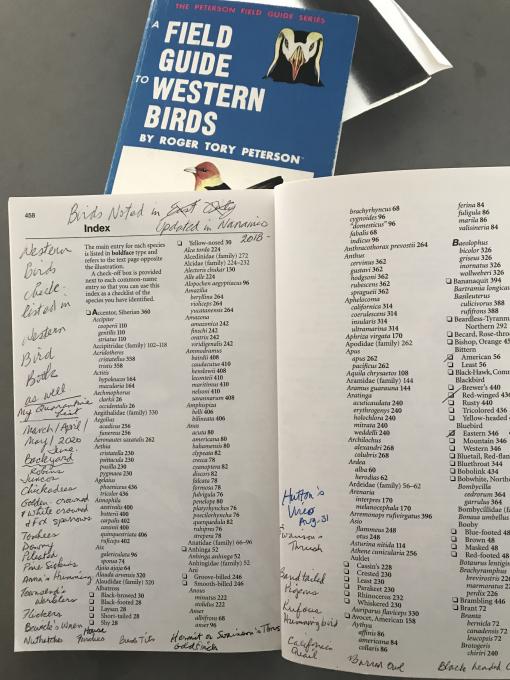
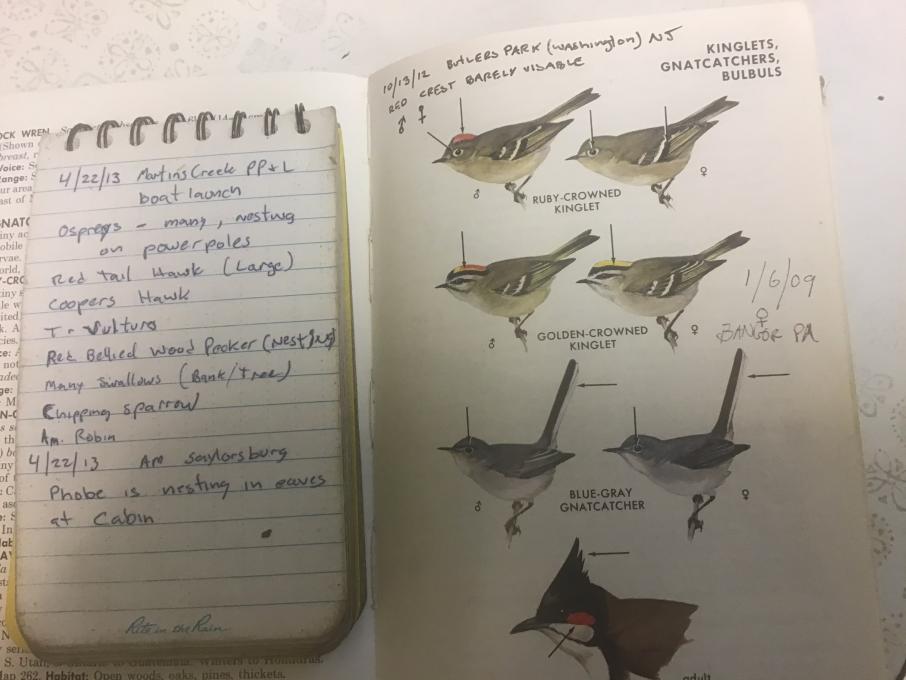 My oldest bird notes were written in my field guide ; when and where I saw the bird as seen on the right side of the photo. Later I began making lists of all the birds I saw, the date and where I was birding as seen on in the notebook on the right.
My oldest bird notes were written in my field guide ; when and where I saw the bird as seen on the right side of the photo. Later I began making lists of all the birds I saw, the date and where I was birding as seen on in the notebook on the right.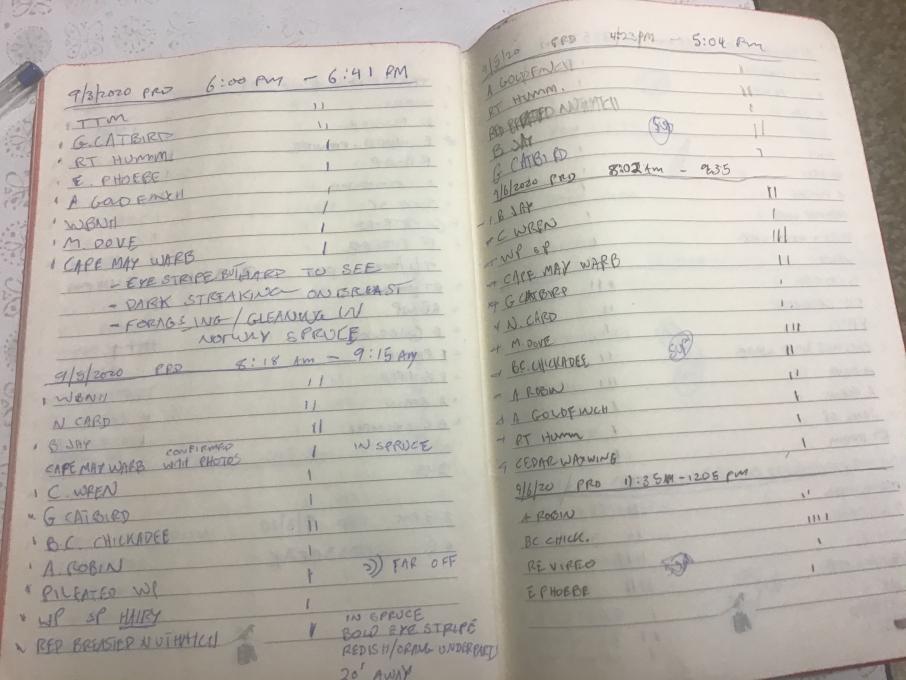 When I began using E-bird I started recording bird counts, start and end times and some notes in addition to the date and location. Most of the places I bird have no cell phone signal so I still record everything in my notebook using a kind of shorthand. I use abbreviations for a lot of the common birds(WBNH- White Breasted Nuthatch, TTM- Tufted Titmouse etc) as well as my usual locations. I also use tick marks for the counts. This makes it easy to add more birds of the same species as I see them.
When I began using E-bird I started recording bird counts, start and end times and some notes in addition to the date and location. Most of the places I bird have no cell phone signal so I still record everything in my notebook using a kind of shorthand. I use abbreviations for a lot of the common birds(WBNH- White Breasted Nuthatch, TTM- Tufted Titmouse etc) as well as my usual locations. I also use tick marks for the counts. This makes it easy to add more birds of the same species as I see them. 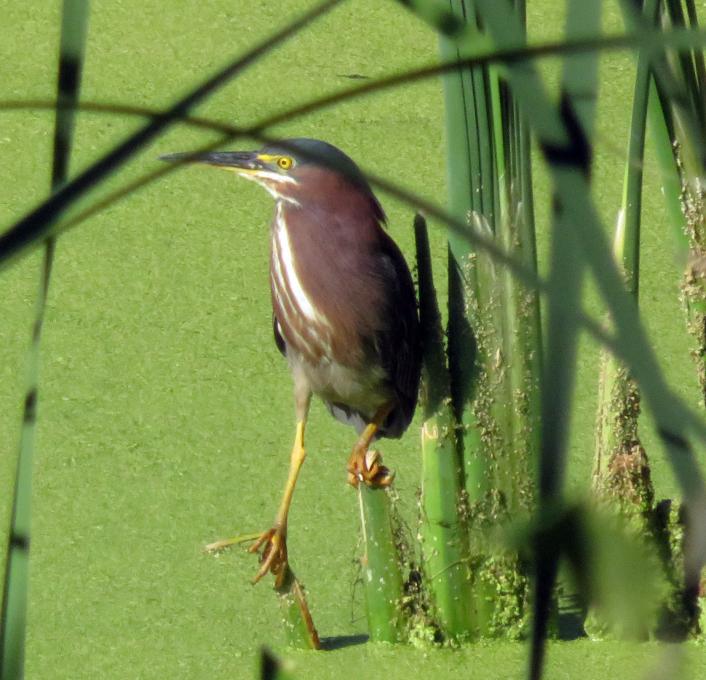
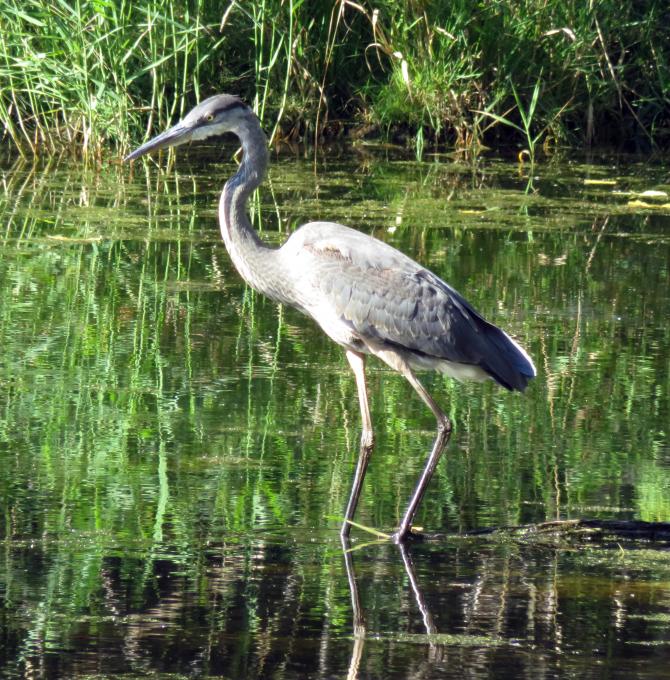
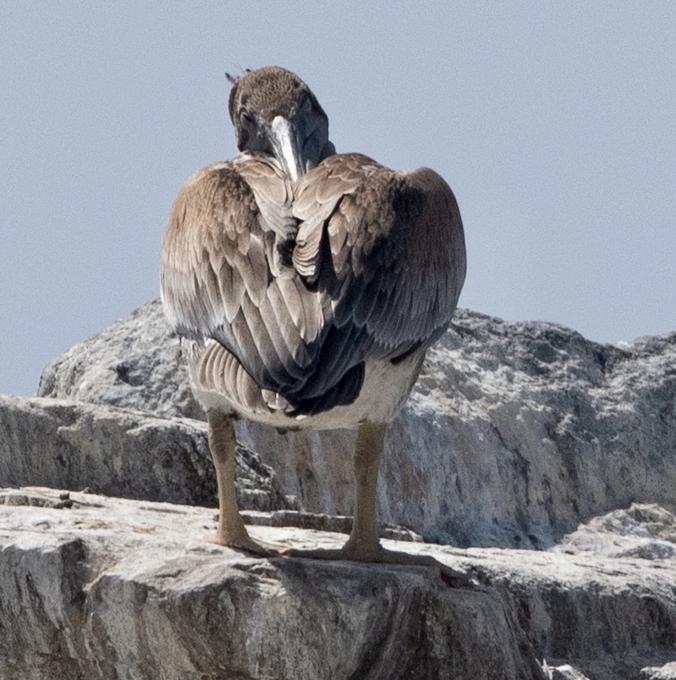
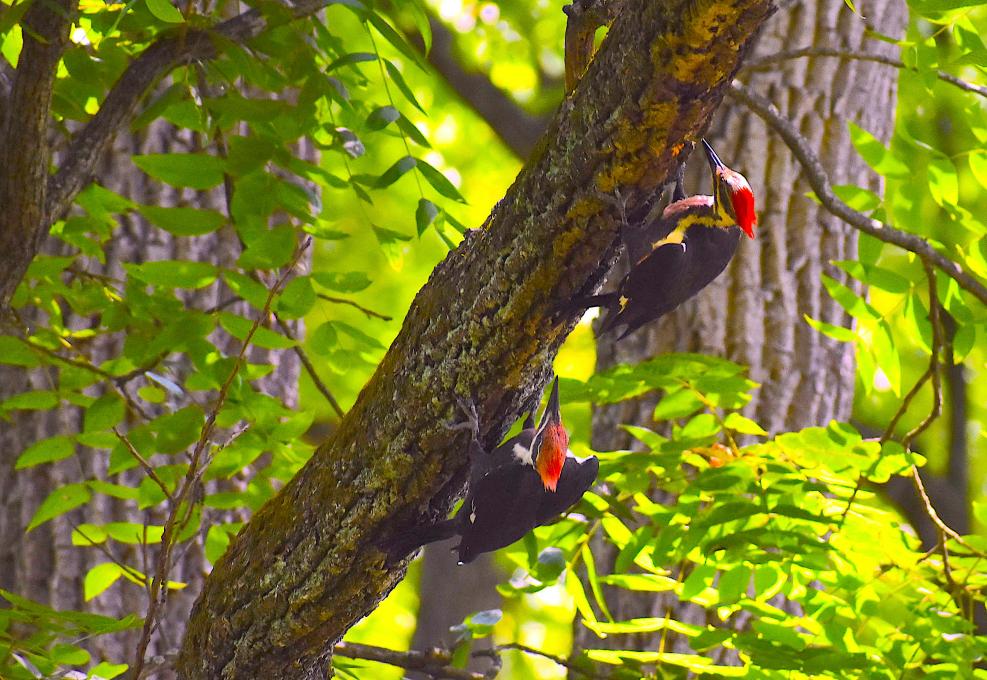
 two Pileated Woodpeckers at once - what a day!!!
two Pileated Woodpeckers at once - what a day!!! 